
Showing posts sorted by relevance for query bollywood. Sort by date Show all posts
Showing posts sorted by relevance for query bollywood. Sort by date Show all posts
Tuesday, 14 June 2016
50 Best Film Shots That Will Make You Believe in the Magic of Classic Bollywood
We’ve compiled a montage of the best film shots from classic Bollywood movies that we feel exemplify the splendor, allure, and excitement of Hindi movies from the Golden Age. Consider these 50 beautiful film shots a glimpse through a keyhole into a much grander world of cinematographic sublimity: behold the magic of classic Bollywood.
This project was kindled in part by my reaction to everyone who’s ever told me, “I love Bollywood!” I get that a lot. Being a film production major who’s worked in the Hindi movie industry, I hear the phrase, “I love Bollywood!” several times a month—from classmates, friends, and random people at parties. Bollywood has become a trend all over the globe—every hipster worth their organic sea salt is familiar with the term, and many have even seen a Hindi film or two themselves. Except I don’t really ever know what to say in reply. It’s not because loving Bollywood isn’t exactly what I look for in new friends (because believe me, it is), but because I don’t understand what that phrase even means.
Let me put this in perspective. To me, this can be the equivalent of someone in rural Punjab who’s seen the Bourne trilogy saying, “I love Hollywood!”
Think about that. What does it mean to love “Hollywood”? Are you saying you love American filmmaking and its history? Celebrity gossip? Or do you really mean to say, “I love action flicks and Matt Damon?” Because Hollywood is not just big-budget androcentric action flicks (although they are a cool part of a big genre). Ryan Gosling kissing Rachel McAdams in the rain is Hollywood. Orsen Welles fighting a smear campaign for governor is Hollywood. Judy Garland singing over a rainbow is Hollywood. And Jack Nicholas running amok in an insane asylum is Hollywood. It’s rare to find someone who knows and loves it all.
So when you say, “I love Bollywood!” to me, as a true lover of all things Bollywood, I don’t know what you’re really referring to. Often people who haven’t had much exposure tend to generalize that elusive term Bollywood to mean “pretty costumes!” or “crazy dancing!” This perception applies just as much to Indians from India as to non-Indians anywhere else. Because Bollywood is not just the melodramatic musical with half-naked women and a loosemasala plot that is often stereotyped. Bollywood is Guru Dutt searching the streets of urban decay for a glimmer of humanity. Bollywood is Meena Kumari dancing kathak upon shattered glass in sorrow. Bollywood is Amitabh Bachhan’s fist meeting the jaws of his twenty adversaries with a satisfying smack. And yes, Bollywood is Aishwarya Rai and Shah Rukh Khan in glittery costumes declaring love in the moonlight. I often yearn to somehow share all the magic of classic Hindi cinema that comes to my mind when I think of Bollywood, because it is a well-hidden treasure for so many of my generation.
Now before someone throws a fit, I get it. Not everyone has the time or interest to become heavily familiarized with Bombay’s film output since the 1930s. Nor should they. All I’m saying is, I wish more people were aware of what Bollywood truly encompasses. When you exclaim, “I love Bollywood!” there is a reason why I can’t bring myself to reply, “OMG, totes!” but instead want to fill your ear with my reverence of the cinematography in Kaagaz Ke Phool (1959). Simply tell me you loved the movie Kuch Kuch Hota Hai (1998) (because, seriously, who didn’t?), or that you thought Deepika Padukone’s outfits were beautiful in that one rom-com. Otherwise, we’ll both end up feeling awkward after I start on my spiel. Yes, I probably overthink this. Yes, most people probably don’t care one way or another. But I can’t imagine living a world without the enchantment of classic Bollywood films, and maybe there are people out there who would want in, if they only knew what they’re missing.
So this montage is the reply I wish I could give everyone, but I cannot articulate–a reply that must be seen to be believed. Because when I respond, “Really? I love Bollywood too!” this is what comes to my mind. This montage is why I love Bollywood. I hope that by watching these shots, you can get a peek into that hypnotizing world yourself, and that you’ll crave more. I hope that this might be a chance to understand that Bollywood is far richer, far more complex, and far more evocative than can be summed up by mere words or by viewing a single film.
Therefore, don’t just take my word for it. Watch the 50 Film Shots That Will Make You Believe in the Magic of Classic Bollywood, and I’ll bet that somewhere deep inside your heart, something faintly stirs in a way you never knew possible. And afterwards, I recommend starting with any of the movies that made our list of the Top 30 Greatest Classic Bollywood Films of All Time. I’ll get off my soap box now. Back to translating obscure old songs where I belong. But send us a comment if this montage resonates with you, and share it with anyone who may have never experienced the wonder of the films to which it pays homage.
Just don’t even get me started on Slumdog Millionaire.
– Mrs. 55

An aged Nargis remembers the trials of her youth in the final shot of the Academy Award-nominated filmMother India (1957).
As a reference, the corresponding films to our 50 selected shots are below. The music playing during the montage is the “Title Music” from Pakeezah (1972).
50 Shots’ Film Names (in order of appearance):
Bandini (1963)
Kaagaz Ke Phool (1959)
Pakeezah (1972)
Aradhana (1969)
Bombai Ka Babu (1960)
Kohra (1964)
Mother India (1957)
Guide (1965)
Shree 420 (1955)
Sangam (1964)
Mughal-e-Azam (1960)
Chinatown (1962)
Caravan (1971)
Shree 420 (1955)
Shree 420 (1955)
Sholay (1975)
Kaagaz Ke Phool (1959)
Pakeezah (1972)
Pakeezah (1972)
Pyaasa (1957)
Bombai Ka Babu (1960)
Umrao Jaan (1981)
Woh Kaun Thi? (1964)
Mehboob Ki Mehndi (1971)
Jab Jab Phool Khile (1965)
Aradhana (1969)
Khamoshi (1970)
Mughal-e-Azam (1960)
Mughal-e-Azam (1960)
Woh Kaun Thi? (1964)
Mother India (1957)
Kaagaz Ke Phool (1959)
Guide (1965)
Andaz (1949)
Mughal-e-Azam (1960)
Aradhana (1969)
Pakeezah (1972)
Jewel Thief (1967)
Aan Milo Sajna (1970)
Anand (1971)
Kaagaz Ke Phool (1959)
Awaara (1951)
Amar, Akbar, Anthony (1977)
Do Raaste (1969)
Kaagaz Ke Phool (1959)
Awaara (1951)
Sholay (1975)
Baazi (1951)
Woh Kaun Thi? (1964)
Mother India (1957)
Wednesday, 13 July 2016
Top ten richest actors of Bollywood
Top ten richest actors of Bollywood:-
Bollywood seems to be unstoppable when it comes to the progress that it is making, with more than 100 movies under the umbrella of Bollywood being released every year. Despite the increasing competition in the Hindi-language movie industry, there seems to be a crème de la crème of Bollywood actors that continue to rule not only the industry but the hearts of millions of fans. Consequently, many of these famous actors have managed build quite the fortune because of their unparalleled success. Thus, this list of the top 10 richest Bollywood stars 2016 provides an insight into the worth of each of these actors.
1. Shahrukh Khan – Net Worth: USD600 million
Shahrukh Khan may not be only at the top of the list, but being the King of Bollywood, he is certainly among the richest Bollywood actors and also a richest actor in the world. In fact, not only he is one of the richest but is also one of the most favorite and popular Bollywood actors, having garnered an international fan following too. Therefore, he earns up to 20 crore Indian rupees per movie and up to 3 crore Indian rupees for every endorsement. He has net worth about USD600 million.
2. Amitabh Bachchan – Net Worth: USD400 million
Amitabh Bachchan has probably touched almost every height of acting, fame, money and success in his 40-year acting career and has earned the title of Bollywood’s Big B. He now charges a reasonable 4 to 5 crore (1 crore = USD214,431) Indian rupees per movie and considering the sheer number of movies he has starred in, he has made his way among the richest Bollywood actors.
3. Salman Khan: 200$ Million

Was born on 27th of December, 1965, Abdul Rashid Salman Khan, credited as Salman Khan is an Indian film actor, producer, and television personality. With the nickname of the Perfectionist, Salman has a net worth of $180 million. He has received so many accolades for his performances which includes 4 National Film Awards and 7 Filmfare Awards.
4. Aamir Khan: $185 Million
Was born 14th of March, 1965, Aamir Khan is an Indian film actor, director, and producer. Thorough his successful career in Hindi films, he has established himself as one of the most popular and influencial actors of Indian cinema. Aamir Khan net worth is an estimated $200 million (Rs 1200 crore) charging Rs 40 Crore salary per movie and nothing less thanks to his known intellect creative dynamism and celebrated talent he is viewed on small and big screen and has become a reputed brand endorsed and financially appreciated on social works.
5. Akshay Kumar: Net Worth $180 Million
Was born on 9th of September, 1967, Rajiv Hari Om Bhatia who is better known by his stage name ‘Akshay Kumar’ is an Indian actor, producer, and martial artist who has appeared in over a hundred Hindi films. He has nominated for Filmfare Awards several times, winning it two times. His net worth is currently rated to be about $180 million. He also has great properties such as a modern bungalow, fleet of cars, and quality bike collections. Research indicated that annually Akshay pockets an income of about 179.85 Crore which is a wonderful income that can always make many people live a better luxurious life.
6. Dharmendra: Net Worth $70 Million
Was born on 8th of December, 1935, Dharmendra is an Indian film actor. In 1997, he received the Filmfare Lifetime Achivement Award for his contribution to Hindi cinema. His starring roles in action films earned him nicknames such as ‘Action King’ and ‘He-Man’. His net worth is currently estimated to be $70 million which he has earned from many films starting from Dil Bhi Tera Hum Bhi Tere in 1960. Over a long career, Dharmendra has acted in more than 100 movies which makes him become well-known is Bollywood industry.
7. Ranbir Kapoor: Net Worth $66 Million
Was born on 28th of September, 1982, Ranbir Kapoor is an Indian actor. Through his career in Bollywood films who has become one of the most popular celebrities and one of the highest-paid actors in India. He is the recipient of several awards including five Filmfare Awards. As for his net worth is concerned, it is the highest figure that he has received in his career. But as per the financial report, he makes a huge income of 30 crores on annual basis as he charges a handsome amount of 15 crores to 20 crores per movie after the success of ‘Yeh Jawaani Hai Dewaani’.
8. John Abraham: Net Worth $55 Million
Was born on 17th of December, 1972, John Abraham is an Indian film actor, producer, and a former model. After modeling for numerous advertisements and companies, Abraham made his film debut with Jism, which earned him a Filmfare Best Debut Award nomination. He is known as a successful name in the industry and has earned net worth of $55 million. He makes an annual income of $12 million and is known to charge a sum of $10 to $12 crores for signing a movie. By the age of just 41 years old, this handsome man earns 80$ Million /Rs 480 Crore in 2015 which is considered as a high amount of income that an actor makes.
9. Irrfan Khan: Net Worth $50 Million
Was born on 7th of January, 1967, Sahabzade Irrfan Khan, credited as Irrfan Khan or simply Irrfan is an Indian film actor known for his works predominantly in Hindi cinema. He is also known for his works in British films as well as Hollywood. Irrfan Khan’s Jurrasic World has broken all records by giving a humongous opening of $511 million worldwide which is the biggest opening ever. Based on his talent and skill in acting in various movies, Irrfan could pull in as much as $4 million per movie with the net worth of $50 million.
10. Hrithik Roshan: Net Worth $45 Million
Was born on 10th of January, 1974, Hrithik Roshan is an Indian film actor who has established a successful career in Bollywood since he has won six Filmfare Awards and has been cited in the media as one of the most attractive male celebrities in India. Since he is a hotshot superstar of the Indian cinema, his net worth is around $45 million Rs 270 Crore while his annual income is Rs 20 Crore. This handsome actor has earned his net worth of $30. As per the trend, he is superstar of Bollywood who began his career as a child and gradually earned his fame as an international actor.
Tuesday, 14 June 2016
20 Gorgeous Waltz Songs from Classic Bollywood Films
Guru Dutt and Mala Sinha are NOT actually waltzing in the iconic song “Hum Aap Ki Ankhon Mein” from Pyaasa (1957).
The waltz is a beautiful dance form with music in triple meter that originated in 16th century Germany. The name is derived from the Latin volvere, describing the ensemble rotations of the dancers. So what place does the waltz have in 20th century Bollywood films? How did this art form cross continents and cultures?
I first starting looking closely at waltz songs in classic Bollywood films when trying to select a song for my husband and my “first dance” at our wedding. I wanted to use an old Bollywood song for this western tradition, and found myself unsure where to start looking. My mind jumped to the most iconic waltz dance from Bollywood I could think of: who doesn’t recall the serene dream sequence from Pyaasa (1957) in which Guru Dutt and Mala Sinha twirl together through the mist? There was just one issue: “Hum Aap Ki Ankhon Mein” was not actually a waltz.
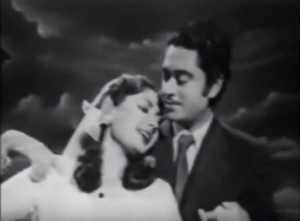
Meena Kumari and Kishore Kumar waltz to O.P. Nayyar’s “Mere Neendon Mein Tum” from Naya Andaz (1956).
Yup. You and I were both fooled. As I discovered the distinct triple meter of the waltz is not ubiquitous in classic Bollywood, nor can you really fake dancing a waltz to anything else. The 3/4 meter of the waltz bears a similarity to the Hindustani dadra 6/8 meter, paving the way for a transition across continents. You can recognize the distinct rhythm of the waltz by listening for a strong first beat followed by two lighter beats. A common mistake is that many people think when dancing the waltz, the first beat is when both dancers move “up.” In reality, that first strong beat is when the dancers may move downwards in unison, and return to normal height (or on the balls of their feet) for the lighter beats following. There are many variations to this pattern, but generally, it gives the waltz dancers that beautiful wave-like cadence as if they are floating across the floor.
The waltz assumes many unexpected incarnations in classic Bollywood, exemplifying everything from urban glamour to girlish excitement to full-out pity party. The first known appearance of waltz in a Bollywood song is in “Hum Aur Tum Aur Yeh Khushi” from Ali Baba(1940) composed by the legendary Anil Biswas. Music director Naushad, known for his brilliant Hindustani classical compositions, helped usher the waltz rhythm into Bollywood mainstream as early as with the tragic “Tod Diya Dil Mera” from Andaz (1949), “Ab Raat Milan Ki” from Jadoo(1951), and “Tara Ri Yara Ri” from Dastan (1952). S.D. Burman highlighted the waltz in his hitHouse No. 44 (1955) with amorous ballads “Phaili Hui Hai Sapnon” and”Chhup Hai Dharti.” By the late 1950s, the waltz was adopted by nearly every composer, developing an important place in Bollywood well into the 1970s.

Nargis’ surprisingly incredible waltz moves school everyone in “Dil Ki Girah Khol Do” from Raat Aur Din (1967). And you thought she was only cut out for the village belle.
In Hindi films, a song with a waltz rhythm need not always portray a couple dancing–in fact, some of the best waltz songs create tension by not showing the couple come together. Other times, such as in Nargis’ incredible performance in Raat or Aur Din (1967), waltzing with ease was a sign of Western sophistication and elitism. The waltz gained a brief romantic revival in the 1990s with the super hit song “Kuch Na Kaho” from 1942: A Love Story (1993). But this song became quickly overdone at every Indian function I attended growing up, so I refused to use it at my own wedding. I needed a list of off-the-beaten-path waltz songs from classic Bollywood that would still make us look stylish.

Raj Kapoor and Nadira dance together singing “Mud Mud Ke Na Dekh,” which begins as a lilting waltz in Shree 420 (1955).
But when I was planning my wedding, I never found that list. It’s as though thousands of men and women out there aren’t actually scrambling to dance to a Mohammed Rafi song in front of all their friends and family. I don’t get it. To the couple out there who wants to have the coolest wedding ever, this list is my gift to you!
20 Waltz Songs from Classic Bollywood Films:
Lag Ja Gale (Woh Kaun Thi? 1964)
Dil Ki Nazar Se (Anadi 1959)
Dil Ki Girah Khol Do (Raat Aur Din 1967)
Mud Mud Ke Na Dekh (Shree 420 1955)
Dil Ke Jharoke (Brahmachari 1968)
Yeh Raaten Yeh Mausam (Dilli Ka Thug 1958)
Mere Neendon Mein Tum (Naya Andaz 1956)
Phoolon Ke Rang Se (Prem Pujari 1969)
Hum Aur Tum Aur Yeh Sama (Dil Deke Dekho 1959)
Udhar Tum Haseen Ho (Mr. and Mrs. ’55 1955)
Yeh Hai Bombay Meri Jaan (C.I.D. 1956)
Jeena Yahan Marna Yahan (Mera Naam Joker 1970)
Main Shayar To Nahin (Bobby 1973)
Phaili Hui Hai Sapnon (House No. 44 1955)
Tod Diya Dil Mera (Andaz 1949)
Chhup Hai Dharti (House No. 44 1955)
Geet Gaata Hoon Main (Lal Patthar 1971)
Tara Ri Yara Ri (Dastan 1950)
Tera Aana Ik Pal Meri (Hum Naujawan 1985)
Aaja Panchi Akela Hai (No Do Gyarah 1957)

My husband and my ‘first dance’ at our wedding: a waltz to Lata Mangeshkar’s “Lag Ja Gale.” When watching the video of us later, it was clear that I was no Nargis, but at least we had fun!
We ultimately decided on the Viennese waltz “Lag Ja Gale” for our first dance, which proved pretty ambitious for two people whose primary dance skills involved interpretive bhangra. Don’t see your favorite Bollywood waltz on our list? Let us know what other Bollywood waltzes you love in the comments!
The Top 30 Best Classic Bollywood Soundtracks of All Time
The best music albums from classic Bollywood have been chosen. Which songs made the list of Bollywood’s top 30 greatest?
Welcome to the greatest music of classic Bollywood! We at Mr. and Mrs. 55 – Classic Bollywood Revisited! have compiled our ultimate list of the top 30 best classic Bollywood film soundtracks of all-time. Music is the very soul of classic Bollywood, a legacy of beauty and style that once lit the world. These soundtracks showcase the most talented artists of Bollywood and are as diverse and transformative as the films to which they lent their magic. Long after the cinema lights fade, this music remains in the air, haunting us with desire, sustaining us through tragedy, and enchanting our daily experiences in the world.
Soundtracks of all Hindi films released between the years of 1945 to 1985 were considered and ranked based on the merit of lyrics, musical composition and complexity, historical and cultural value, vocal performance, and accomplishments of the soundtrack elements as an ensemble. Topping our list are composers Sachin Dev Burman, Rahul Dev Burman, Naushad, and the duo Shankarsingh Raghuwanshi and Jaikishan Dayabhai Panchal (often credited as Shankar-Jaikishen) whose works both defined and reinvented Bollywood. Like our enormously popular list of the Top 30 Greatest Classic Bollywood Films of All Time, these soundtracks embrace the unexpected.
The advent of music in Bollywood binds the stormy history of a shackled India emerging from depression and war with the golden age of Hollywood musical film. Many believe that films with de rigeur musical numbers is a unique hallmark of Hindi cinema. However, the early “talkie” pictures of India such as Alam Ara (1931) were heavily influenced by the popular western films like The Jazz Singer (1927) and Showboat (1929) in which the new sound technology instantly propelled musical film as the most profitable genre. Hollywood directors like Busby Berkeley whose signature spectacle was the mass ornament and nimble-footed singer-dancers like Fred Astaire and Ginger Rogers helped contribute to the hundreds and hundreds of musical films cherished by the western world during the 1930s-1950s. The then universal convention of five to seven musical numbers peppering a film was easily embraced and adapted by Hindi movie directors who introduced Hindustani musical traditions to their work. Playback singers such as Lata Mangeshkar, Mohammed Rafi, Kishore Kumar, and Asha Bhonsle were as celebrated as the actors for whom they lent their voices. Often before a film was released, a Bollywood movie’s soundtrack was played repeatedly on the radio, reaching the hearts of millions across the country who may not have afforded the luxury to see the actual film in theatres.
While Hollywood eventually diverged from the musical film genre by the late 1960s, India was awakening to its own golden era of film in which music dominated the sensory milieu. Perhaps it was the escapism of music with its perfect harmonies and piercing poetry that touched the newly freed country still finding its identity. From solemn hymns of the countryside to feverish cabarets of city nightlife, from extravagant orchestras to solitary sitar solos, and from singers whose voices seem to descend from heaven, these soundtracks unleashed new eras of possibility and romance. The music of classic Bollywood will change you forever. For a few fleeting minutes, the ideals you dreamed of are made real.
Take this journey with us through the best music albums of yesteryear Hindi cinema. This music the way is was meant to be. This is classic Bollywood.
The Top 30 Best Classic Bollywood Soundtracks of All Time:
1. Pakeezah
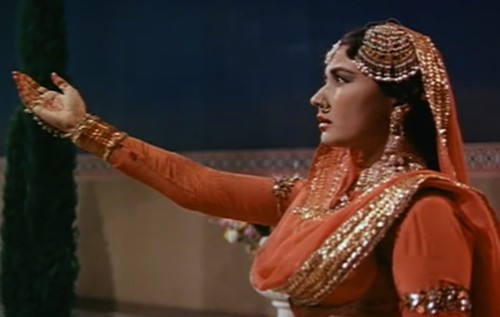
Ghulam Mohammed and Naushad, 1971
Chalte Chalte – Lata Mangeshkar
Taare Rahiyo – Lata Mangeshkar
Teer-e Nazar – Lata Mangeshkar
Chalo Dildar Chalo – Lata Mangeshkar and Mohammed Rafi
Inhi Logon Ne – Lata Mangeshkar
Mausam Hai Aashiqana – Lata Mangeshkar
Title Music/Alap – Lata Mangeshkar
2. Guide

S.D. Burman, 1965
Din Dhal Jaaye – Mohammed Rafi
Aaj Phir Jeene Ki – Lata Mangeshkar
Piya Tose – Lata Mangeshkar
Tere Mere Sapne – Mohammed Rafi
Gaata Rahe Mera Dil – Lata Mangeshkar and Mohammed Rafi
Kya Se Kya Ho Gaya – Mohammed Rafi
Saiyan Beiman – Lata Mangeshkar
3. Mughal-e-Azam

Naushad, 1960
Teri Mehfil Mein Qismat – Lata Mangeshkar and Shamshad Begum
Pyar Kiya To Darna Kya – Lata Mangeshkar
Mohe Pangat Pe – Lata Mangeshkar
Mohabbat Ki Jhooti Kahani – Lata Mangeshkar
Aye Mohabbat Zindabad – Mohammed Rafi
Prem Jogan Ban Ke – Ustad Bade Ghulam Ali Khan
Yeh Dil Ki Lagi – Lata Mangeshkar
Title Music
4. Nagin
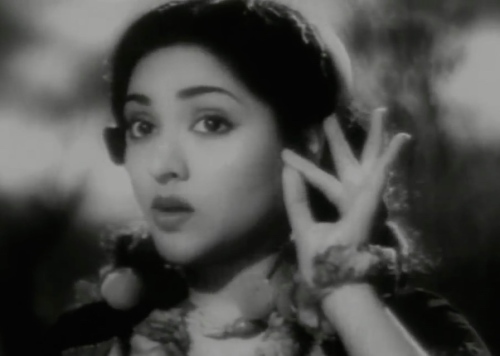
Hemant Kumar, 1954
Man Dole Mera – Lata Mangeshkar
Jadugar Saiyan – Lata Mangeshkar
Tere Dwar Khada Ek Jogi – Hemant Kumar
Mera Dil Yeh Pukare Aaja – Lata Mangeshkar
Sun Ri Sakhi – Lata Mangeshkar
Yaad Rakhna Pyar Ki Nishani – Asha Bhonsle and Hemant Kumar
5. Aradhana

S.D. Burman, 1969
Roop Tera Mastana – Kishore Kumar
Mere Sapnon Ki Rani – Kishore Kumar
Kora Kaagaz Tha – Lata Mangeshkar and Kishore Kumar
Gunguna Rahe Hai Bhanware – Asha Bhonsle and Mohammed Rafi
Baghon Mein Bahar Hai – Mohammed Rafi and Lata Mangeshkar
Saphal Hogi Teri Aradhana – S.D. Burman
6. Teesri Manzil

R.D. Burman, 1966
Aaja Aaja – Asha Bhonsle and Mohammed Rafi
Deewana Mujhsa Nahin – Mohammed Rafi
O Haseena Zulfonwali – Asha Bhonsle and Mohammed Rafi
O Mere Sona Re – Asha Bhonsle and Mohammed Rafi
Tumne Mujhe Dekha – Mohammed Rafi
7. Barsaat

Shankarsingh Raghuwanshi and Jaikishan Dayabhai Panchal, 1949
Hawa Mein Udta Jaye – Lata Mangeshkar
Chhod Gaye Balam – Lata Mangeshkar and Mukesh
Jiya Beqarar Hai – Lata Mangeshkar
Mujhe Kisise Pyar – Lata Mangeshkar
Patli Kamar Hai – Lata Mangeshkar and Mukesh
8. Anarkali

C. Ramachandra, 1953
Yeh Zindagi Usiki Hai – Lata Mangeshkar
O Zindagi Ke Denewale – Hemant Kumar
O Aasmanwale – Lata Mangeshkar
Jaag Dard-e-Ishq – Lata Mangeshkar and Hemant Kumar
Mohabbat Aisi Dhadhkan Hai – Lata Mangeshkar
Mujhse Mat Pooch – Lata Mangeshkar
Aaja Ab To Aaja – Lata Mangeshkar
9. Kati Patang
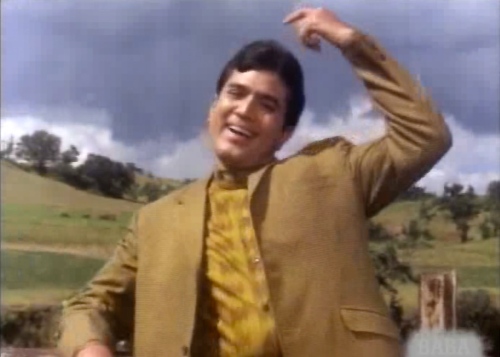
R.D. Burman, 1970
Jis Gali Mein – Mukesh
Yeh Jo Mohabbat Hai – Kishore Kumar
Na Koi Umang Hai – Lata Mangeshkar
Yeh Shaam Mastani – Kishore Kumar
Pyaar Diwanaa Hota Hai – Kishore Kumar
Aaj Na Chhodenge – Lata Mangeshkar and Kishore Kumar
10. Chori Chori

Shankarsingh Raghuwanshi and Jaikishan Dayabhai Panchal, 1956
Panchi Banoon Udti – Lata Mangeshkar
Aaja Sanam – Lata Mangeshkar and Manna Dey
Jahan Main Jaati Hoon – Lata Mangeshkar and Manna Dey
Yeh Raat Bheegi Bheegi – Lata Mangeshkar and Manna Dey
Rasik Balma – Lata Mangeshkar
Man Bhavan Ke Ghar – Lata Mangeshkar and Asha Bhonsle
11. Taj Mahal
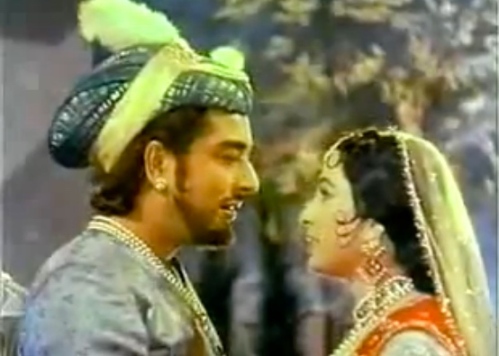
Roshan, 1963
Jo Wada Kiya Woh – Lata Mangeshkar and Mohammed Rafi
Jo Baat Tujh Mein Hai – Mohammed Rafi
Jurm-e Ulfat Pe – Lata Mangeshkar
Paaon Choo Lene Do – Lata Mangeshkar and Mohammed Rafi
Chandi Ka Badan – Asha Bhonsle and Mohammed Rafi
12. Hum Dono

Jaidev, 1961
Abhi Na Jao Chhod Kar – Asha Bhonsle and Mohammed Rafi
Allah Tero Naam – Lata Mangeshkar
Kabhi Khud Pe – Mohammed Rafi
Main Zindagi Ka Saath – Mohammed Rafi
Prabhu Tero Naam – Lata Mangeshkar
13. Jewel Thief

S.D. Burman, 1967
Honton Pe Aisi Baat – Lata Mangeshkar
Aasman Ke Neeche – Lata Mangeshkar and Kishore Kumar
Dil Pukare – Lata Mangeshkar and Mohammed Rafi
Rulake Gaya Sapna – Lata Mangeshkar
Yeh Dil Na Hota – Kishore Kumar
Title Music
14. Caravan
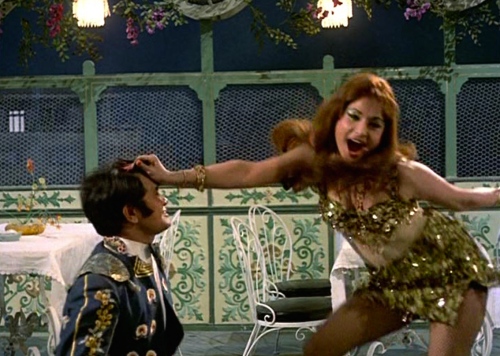
R.D. Burman, 1971
Piya Tu Ab To – Asha Bhonsle
Chadti Jawani – Lata Mangeshkar and Mohammed Rafi
Kitna Pyara Wada – Lata Mangeshkar and Mohammed Rafi
Goriya Kahan – Asha Bhonsle and Mohammed Rafi
Ab Jo Mile Hai – Asha Bhonsle
15. Bobby

Laxmikant Shantaram Kudalkar and Pyarelal Ramprasad Sharma, 1973
Main Shayar To Nahin – Shailendra Singh
Bahar Se Koi Andhar – Lata Mangeshkar and Shailendra Singh
Jhoot Bole Kauwa Kate – Lata Mangeshkar and Shailendra Singh
Mujhe Kuch Kehna Hai – Lata Mangeshkar and Shailendra Singh
Na Mangoon Sona Chandi – Manna Dey and Shailendra Singh
16. Pyaasa

S.D. Burman, 1957
Jaane Woh Kaise – Hemant Kumar
Aaj Sajan Mohe – Geeta Dutt
Hum Aap Ki Ankhon Mein – Geeta Dutt and Mohammed Rafi
Jane Kya Tune Kahi – Asha Bhonsle
Yeh Duniya Agar Mil Bhi Jaaye – Mohammed Rafi
17. Abhiman

S.D. Burman, 1973
Tere Mere Milan – Lata Mangeshkar and Kishore Kumar
Nadiya Kinare – Lata Mangeshkar
Tere Bindiya Re – Lata Mangeshkar and Mohammed Rafi
Piya Bina – Lata Mangeshkar
Ab To Hai Tumse – Lata Mangeshkar
18. Anand

Salil Choudhury, 1971
Zindagi Kaisi Hai Paheli – Manna Dey
Kahin Door Jab Din – Mukesh
Maine Tere Liye Hi – Mukesh
Na Jiya Lage Na – Lata Mangeshkar
19. Kabhi Kabhi

Mohammed Zayur Khayyam, 1976
Kabhi Kabhi Mere Dil Mein – Lata Mangeshkar and Mukesh
Pyar Kar Liya To – Kishore Kumar
Main Pal Do Pal Ka – Mukesh
Mere Ghar Aayi Ek – Lata Mangeshkar
Tere Chehre Se – Lata Mangeshkar and Kishore Kumar
20. Baiju Bawra

Naushad, 1952
O Duniya Ke Rakhwale – Mohammed Rafi
Man Tarpat Hari Dar – Mohammed Rafi
Mohe Bhool Gaye Sanwariya – Lata Mangeshkar
Jhoole Mein Pawan Ke – Lata Mangeshkar and Mohammed Rafi
Tu Ganga Ki Mauj – Lata Mangeshkar and Mohammed Rafi
21. Mother India

Naushad, 1957
Duniya Mein Hum Aaye Hain – Lata Mangeshkar, Usha Mangeshkar, and Meena Mangeshkar
Ghunghat Nahin Kholungi – Lata Mangeshkar
Nagari Nagari Dware Dware – Lata Mangeshkar
O Janewalo Jao Na – Lata Mangeshkar
O Gadiwale – Shamshad Begum and Mohammed Rafi
22. Madhumati

Salil Choudhury, 1958
Aaja Re Pardesi – Lata Mangeshkar
Dil Tadap Tadap – Lata Mangeshkar and Mukesh
Suhana Safar – Mukesh
Ghadi Ghadi Mora Dil – Lata Mangeshkar
Chadh Gayo Papi Bichua – Lata Mangeshkar and Manna Dey
23. Basant Bahar

Shankarsingh Raghuwanshi and Jaikishan Dayabhai Panchal, 1956
Duniya Na Bhaye Mohammed Rafi
Bhaye Bhanjana – Manna Dey
Ja Ja Re Ja – Lata Mangeshkar
Main Piya Teri – Lata Mangeshkar
Nain Mile Chain Kahan – Lata Mangeshkar and Manna Dey
24. Aar Paar
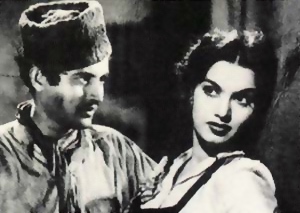
O.P. Nayyar, 1954
Babuji Dheere Chalna – Geeta Dutt
Sun Sun Sun Zalima – Geeta Dutt and Mohammed Rafi
Kabhi Aar Kabhi Par – Shamshad Begum
Yeh Lo Main Haari Piya – Geeta Dutt
Hoon Abhi Main Jawan – Geeta Dutt
25. Kashmir Ki Kali

O.P. Nayyar, 1964
Deewana Hua Badal – Asha Bhonsle and Mohammed Rafi
Isharon Isharon – Asha Bhonsle and Mohammed Rafi
Subhan Allah Haseen – Mohammed Rafi
Kisi Na Kisi Se – Mohammed Rafi
Meri Jaan Balle Balle – Asha Bhonsle and Mohammed Rafi
26. Bandini
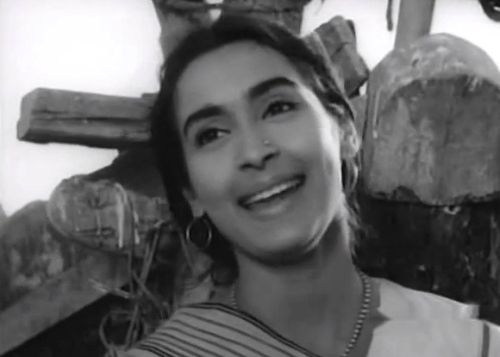
S.D. Burman, 1963
Ab Ke Baras Bhej – Asha Bhonsle
O Re Mahji – S.D. Burman
Mora Gora Ang Laile – Lata Mangeshkar
Jogi Jab Se Tu Aaya – Lata Mangeshkar
O Janewale Ho Sake – Mukesh
27. Sangam

Shankarsingh Raghuwanshi and Jaikishan Dayabhai Panchal, 1964
Yeh Mera Prem Patra – Mohammed Rafi
Bol Radha Bol – Mukesh
Dost Dost Na Raha – Mukesh
O Mehbooba – Mukesh
Har Dil Jo Pyar Karega – Lata Mangeshkar
28. Yaadon Ki Baraat

R.D. Burman, 1973
Chura Liya Hai – Asha Bhonsle and Mohammed Rafi
Aapke Kamre Mein – Asha Bhonsle and Kishore Kumar
Lekar Hum Deewana Dil – Asha Bhonsle and Kishore Kumar
Meri Soni Meri Tamana – Asha Bhonsle and Kishore Kumar
Yaadon Ki Baraat – Mohammed Rafi and Kishore Kumar
29. Amar Prem

R.D. Burman, 1972
Chingari Koi Bhadke – Kishore Kumar
Raina Beeti Jaaye – Lata Mangeshkar
Kuch To Log Kahenge – Kishore Kumar
Yeh Kya Hua – Kishore Kumar
Bada Natkhat Hai Yeh – Lata Mangeshkar
30. Umrao Jaan
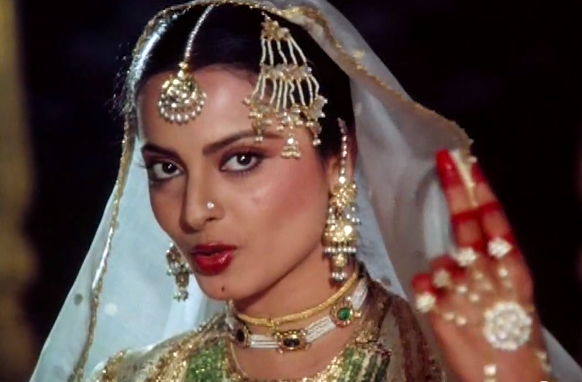
Mohammed Zayur Khayyam, 1981
In Ankhon Ki Masti – Asha Bhonsle
Dil Cheez Kya Hai – Asha Bhonsle
Justuju Jiski Hai – Asha Bhonsle
Yeh Kya Jagah Hai – Asha Bhonsle
Jab Bhi Milti Hai – Asha Bhonsle
Find out more about these and other classic Bollywood soundtracks on our song pages! Which soundtracks do you consider among classic Bollywood’s all-time best and why? Leave us a comment and let us know!
The Top 30 Greatest Classic Bollywood Films of All Time
The top 30 greatest classic Bollywood films have been selected. Which films made the list of Bollywood’s best?

Introduction
Mr. and Mrs. 55 – Classic Bollywood Revisited! at last present our definitive list of theBollywood classics you absolutely must see before you die. Hundreds of films were scored and ranked across multiple dimensions of Bollywood cinema including: story, direction, performances, musical composition, as well as cultural impact and legacy. We included Hindi-language films made between the period of 1949-1979 on our list of the best classic Bollywood films ever made. Some on the list are beloved favorites of the industry, while others may surprise you.
Among the winners are directors Guru Dutt, Bimal Roy and Raj Kapoor–names synonymous with masterpiece Indian cinema–each with multiple films among Bollywood’s all-time greatest. Always wondered why a couple of young Harvard students like us love old Indian films so passionately? No matter what you think you know about Bollywood, the movies on this list will change your understanding of Indian films like never before. From village epics that grapple with our national identity to the nostalgic poetry of sudden disillusionment, classic Bollywood films transport us from the enchanting glamour of Bombay nightlife to the majestic gardens of Kashmir. They carry our souls through hardship and loss and revive our spirits with redemption.
This is cinema the way it was meant to be. This is classic Bollywood.
The top 30 Films from 30 years of classic Hindi cinema (1949-1979):
1. Pyaasa

Guru Dutt, 1957
Pyaasa, or “thirst,”is the story of one man’s search for compassion in the cold cynicism of post-independence Indian society. Vijay is an unpublished poet, dismissed by his own family and scorned by socialites and his colleagues. After befriending a prostitute who shelters him, Vijay is believed dead and his poetry “posthumously” lionized. He becomes an overnight sensation, mourned by fans across the country, and the true Vijay is labeled an imposter. India entered its golden age of filmmaking in the 1950s when its long-awaited freedom from England and the hopes of a new government created a social tinderbox of great expectations and disillusionment. Pioneering the technique of utilizing song lyrics as direct extensions of the film’s dialogue, Guru Dutt as the writer-producer-director-star paints a stirring portrait of the commodification of humanity.
2. Mughal-e-Azam

Karimuddin Asif, 1961
At the turn of the 17th century, Prince Salim falls in love with the court dancer Anarkali and wages war against his own father, Emperor Akbar, in order to marry her. Director K. Asif’s enormous cast, opulent sets, intricately designed costumes and extravagantly staged battle scenes made the film the most expensive ever produced in India at the time. But despite of all the grandeur, the film has a warm heart, and the dangers of the romance between Salim and Anarkali are infused into each glance they share. Although the love story is the backbone of the film, it is Emperor Akbar, from whom the film derives its name (“the Great Mughal”), who takes center stage as he is torn between love for his only son and the unforgiving demands of the Mughal Empire. Every line of dialogue is written with the ornamentation of poetry, casting an elegance to Mughal-e Azam‘s thunderous power.
3. Pakeezah

Kamal Amrohi, 1971
In the grandeur of Muslim Lucknow at the turn of the century, Pakeezah is a courtesan and dancer who dreams of leaving her life behind when a stranger falls in love with her in a train compartment, not knowing her true profession. With swirling romanticism and languid, dream-like cinematography, Pakeezah instantly became one of the most extraordinary musicals ever made. Perfectionist director Kamal Amrohi, who also wrote the script and some of the lyrics, effectively transports the viewer into a wistful age of bygone formality and luxury. Each ofPakeezah‘s popular semi-classical songs illustrates the duality of a courtesan’s poetry, at once glamorizing the elaborate rituals of love and destroying the institutions that upheld them.
4. Mother India

Mehboob Khan, 1957
With tragedy strikes her family, newlywed village belle Radha is determined to weather a crucible of social and personal adversities without compromising her honor. In doing so, she reinvents herself as a heavy-handed symbol of India’s own pride as an ancient culture and a new democracy. A defining film in the history of Bollywood, director Mehboob Khan’s iconicMother India set the pattern for the more than 60 years of Bollywood film that followed it. A mythologization of traditional values and an homage to the beauty of Indian heritage, Mother India‘s unabashedly epic glorification of self-sacrifice and female empowerment was nominated for the Academy Award for Best Foreign Film in 1958.
5. Guide

Vijay Anand, 1965
A corrupt businessman is transformed into a spiritual guide after a misunderstanding that leads to his idolization by a village besieged by drought. Based on the R.K. Narayan novel of the same name and bolstered by a stunning soundtrack, Guide explores a fundamental Vedictransformation from materialism to a release from worldly attachments in an extremely unlikely hero. A scandalous love story settles into the background as director Vijay Anand boldly deconstructs social taboos, from adultery and non-traditional gender roles to religious fraud, in a film that stirringly evolves into a philosophical awakening greater than the circumstances it portrays–a brilliant reflection of the double entendre intended by its title.
6. Kaaghaz Ke Phool

Guru Dutt, 1959
In the 1950s at the height of India’s golden age of film-making, a celebrated movie director feels uninspired by the tinsel-lined glitz of studio era Bollywood. When he discovers a new actress, innocent to the corruption of the industry, he believes he has found a muse to ease his restlessness. A elegiac behind-the-scenes film about film-making, Kaaghaz Ke Phool became a cult classic following the eerie semi-autobiographical death of its director Guru Dutt. Trapped in a world of pretense, Guru Dutt illustrates a kind of yearning that softly and slowly erodes the soul–a desperate hunt for a human connection. The real triumph is in the film’s stunning camerawork, gracefully gliding through the empty studio sets like a beautiful spectre of Dutt’s own shattered desires.
7. Awaara

Raj Kapoor, 1951
A female lawyer is determined to prove her lover’s innocence in a murder attempt on the life of a respected judge. Structured in medias res, the film’s flashback reveals the injustice of her lover’s past when the very judge who condemns him proves to be his own father: a man who threw his wife onto the streets when he believed a criminal had raped her. Echoing the dark lessons of the ancient Ramayana, Awaara shatters the nature versus nurture debate with a showman’s flair and surrealist fantasy, including the film’s legendary dream sequence evoking a descent into Hell. Awaara launched Raj Kapoor’s famous Chaplin-esque hero for the first time, who resonated immensely across the Soviet Union and Communist China as the voice of a new generation.
8. Sahib, Bibi, Aur Ghulam

Guru Dutt/Abrar Alvi, 1962
Desperate to save her marriage, the younger daughter-in-law of a wealthy family sacrifices her moral boundaries to win over her alcoholic husband. A nostalgic glimpse into the decaying Bengali feudal system, Sahib, Bibi, Aur Ghulam unravels a dazzling murder mystery at the heart of its progressive view of societal redemption. Seen from the perspective of a young factory worker lured into a stately mansion as an ally of its young mistress, Sahib, Bibi, Aur Ghulamhauntingly opens the doors to the hollowness of exterior splendor. Spiraling against her will with the collapse of Calcutta’s landed aristocracy, Meena Kumari’s portrayal of the tormented wife is forever considered among the most magnificent on-screen performances of Bollywood history.
9. Aradhana

Shakti Samanta, 1971
When her lover dies at war, an unwed mother gives up her son up for adoption, vowing to watch over him in secrecy as he grows up in the house of another. Her poignant worship, oraradhana, of her dead fiancé and their son became immortalized in the Indian cinematic psyche as an audacious struggle of traditional society confronted by changing modern values. Boasting one of the all-time greatest soundtracks of Indian cinema, Aradhana epitomizes the versatility and creativity of the era’s leading music directors. From the youthful joy of “Mere Sapno Ki Rani” to the grim Bardic undertones of “Safal Hogi Teri Aradhana” to the notoriously seductive “Roop Tera Mastana,” the film is as much remembered for its luminous performances as for exemplifying the golden age of Bollywood music.
10. Do Bigha Zameen

Bimal Roy, 1953
A farming family fights to save their ancestral land from a cunning mill owner. Do Bigha Zameen follows the father and son’s trip to Calcutta from their idyllic village to earn enough money to pay their debts–only to discover the miseries of urban poverty instead. Inspired by the work of Italian neorealism, Do Bigha Zameen pioneered early parallel cinema with a deliberate attention to the “everyday,” and the feeling of an invisible, unhurried camera whose shots and mis-en-scene are both carefully constructed and effortlessly fluid. Directed by Bengali auteur Bimal Roy, the film’s nationalistic electricity hit a broader audience, becoming the first Indian film to win the Prix Internationale at the 1954 Cannes Film Festival.
11. Bandini
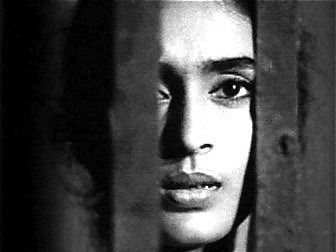
During the British Raj of the 1930s, a prison doctor falls in love with a convict who reveals the story of her tumultuous connection to a freedom fighter.
12. Madhumati

Bimal Roy, 1958
On a rainy night, a man enters an abandoned mansion where he is confronted by unfulfilled visions of his past life.
13. Shree 420

Raj Kapoor, 1955
A country boy travels to Bombay to make his fortune where he is lured from the path of virtue into a thrilling life of deceit.
14. Sholay

Ramesh Sippy, 1975
After his family is murdered by a notorious bandit, a former police officer enlists the help of two outlaws to capture him.
15. Ankur

Shyam Benegal, 1974
The social hierarchies of rural India are disrupted when a landowner begins an affair with a poor farmer’s wife.
16. Hum Dono

Amarjeet, Vijay Anand (1961)
After returning from war, a soldier begins to lead a double-life when his doppelgänger’s family welcomes him home.
17. Barsaat (1949)

Raj Kapoor, 1949
Two men with different ideals of love search for answers with the coming of the monsoons.
18. Amar Akbar Anthony

Manmohan Desai, 1977
Three brothers are separated in childhood and eventually unite after one is brought up a Christian, one a Hindu, and one a Muslim.
19. Anand

Hrishikesh Mukherjee, 1971
A doctor recounts the story of a terminally ill man who wishes to his live life to the fullest and spread happiness to those around him.
20. Haqeeqat

Chetan Anand, 1964
A platoon of Indian soldiers leave their homes and loved ones to encounter the harsh realities of battle in the Indo-China War of 1962.
21. Don

Chandra Barot, 1978
A simpleton is trained to infiltrate the underworld by impersonating a criminal leader who has been killed in a police chase.
22. Mahal

Kamal Amrohi, 1949
A young lawyer is haunted by a ghostly woman in his new house, where the builder and his fiancée died shortly after it was built.
23. Sangam

Raj Kapoor, 1964
An Indian Air Force Officer leaves for the Kashmiri front, entrusting his wife to the care of his best friend who has secretly always loved her.
24. Dosti

Satyen Bose, 1964
A penniless orphan makes the unexpected friendship of a blind boy who teaches him survival on the streets of Bombay.
25. Waqt

Yash Chopra, 1965
Natural disaster separates the members of a close-knit family who re-connect in a series of dramatic entanglements years later.
26. Deewar

Yash Chopra, 1975
A mother attempts to reunite her two estranged sons: one, a leading criminal of the underworld, and the other, an uprighteous policeman.
27. Kati Patang

Shakti Samanta, 1970
As a promise to raise the child of her dying friend, a young woman risks starting a new life under a false identity.
28. Aandhi

Gulzar, 1975
A powerful politician struggles to reconcile her position with secrets from her past.
29. Purab Aur Paschim

Manoj Kumar, 1970
East clashes with West when a traditional Indian student encounters swinging London society for the first time.
30. Bombai Ka Babu

Raj Khosla, 1960
A small-time thief is forced into a deadly web of deception when he gains the trust of his victim’s family.
Read more about these and other classic Bollywood films on our film pages! Which films do you consider among classic Bollywood’s all-time best and why? Leave us a comment and let us know!
– Mrs. 55












.jpg)

